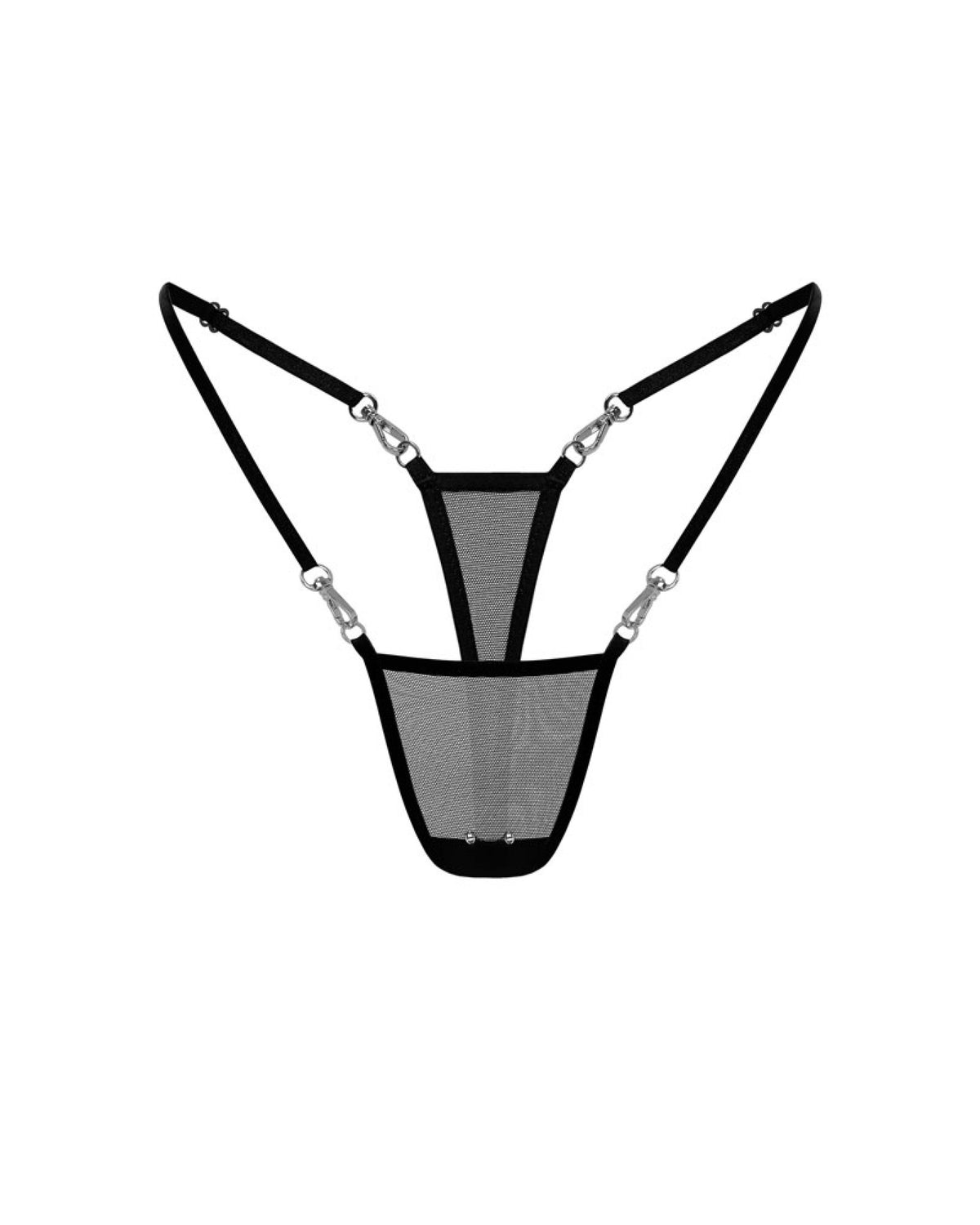
May 08, 2019
What is the mysterious BDSM world?
BDSM blog: What is the mysterious BDSM world?
We love educating people about BDSM but our team also designs harnesses, restraints, leather lingerie, latex and mesh bodywear, corsets and much more.
Browse our selection and discover luxurious and sexy garments for any taste, size, or gender. And now let's get back to the topic.
Many people are accustomed to treating people who are fond of the BDSM culture as seriously ill and need urgent treatment. What really hides behind this abbreviation and is it true that practically each of us has something in common with sado-maso fans?
What is the first thing that comes to mind when you hear the abbreviation BDSM? Strange people in black leather BDSM clothing, with whips and in submissive collars, with gags in their mouths, hurting each other in the most sophisticated ways and deriving from this masochistic pleasure.
For the most part, the fear of the BDSM culture among ordinary people is caused by the problematic depiction of this practice in porn, its controversial presentation in popular films, and the fact that people know almost nothing about it. And they do not even realize that they themselves can easily fit into the flow of this culture only by analyzing their own sexual preferences.
But regardless of whether you consider yourself to be exactly BDSM devotees or consider completely vanilla, most people at one time or another have tried something a little naughty or reckless in their bedrooms in their sex lives, from blindfolded eyes and handcuffs to erotic furniture and BDSM toys and all this may fall under the definition of BDSM acts.
So, we are here to clarify some things …
Etymology of BDSM
Let's first understand the concepts. The term “BDSM” is not defined in four words, as it may seem at first sight. “BD” - bondage and discipline, “DS” - domination and submissiveness, “SM” - sadism and masochism.
Do you know where luxurious BDSM accessories live? Search anoeses.com for harnesses, bondage gear, leather & latex lingerie, and get a 10% discount on your first order.
Bondage and discipline
Bondage and discipline is a form of role-playing game involving the fixation by one of the partners of the other through binding, handcuffing, using adhesive tape or other devices. Here bondage is holding the partner in one, usually extremely uncomfortable, pose.
Discipline implies certain rules in the game, in violation of which the partner who is below receives punishment. BDSM is the most risky kind of sex, and bondage is its most dangerous aspect.
This game is only suitable for partners who absolutely trust each other, because, having lost the ability to move, the "bottom" partner gives himself completely to the power of his Master. And if the leader suddenly manifests himself as a mentally unbalanced character or even a maniac, the outcome of the session can be tragic.
In addition, the very binding, made by inept hands, can not only harm health but also be fatal. Therefore, people who are truly interested in BDSM usually study the binding techniques in detail and attend special masterclasses.
Role-play “bondage and discipline” is suitable for couples in which one prefers to enjoy full power over the partner’s body, while the other wants to feel himself in a defenseless and highly dependent position.
Domination and submission
Jay Wiseman, an experienced BDSM practitioner, writes in his book SM101: “I can instantly determine whether dominant or submissive tendencies prevail in a person. You just have to invite him to sit down. If he is a submissive, he will immediately sit down. The dominant will hold his gaze on me for a moment, thinking about the offer for a couple of seconds. ” From this it follows that the dominant and subordinate are primarily psycho-types.
Domination and submission can be seen not only in the aspect of sexual games, but also as a model of family relationships. After all, a person inclined to leadership is the Dominant (abbreviated as “Dom” - for naming a man and “Domina” - for a woman). Domination includes all kinds of power over a partner.
Sadism and masochism
Role-playing game “sadism - masochism” involves causing pain (physical or psychological). Accordingly, a sadist is satisfied by causing pain, and a masochist by receiving it.
Two historical figures with their names define these names: Frenchman Marquis de Sade and Austrian Leopold von Sacher-Masoch. Both were writers in whose works the heroes indulged in so-called “sexual perversions” with elements of physical and mental humiliation.
So the infliction of pain belongs precisely to the sphere of “sadism and masochism”. The pain can also manifest itself in other role-playing games (for example, as a consequence of bondage), but in them it is not the main goal, but rather a side effect.
The pain can be delivered in a variety of ways and can vary in intensity: from dripping on the body with hot wax from a candle to flogging and tougher effects.
Actually, if during sex the partner likes to take her partner’s head by the hair, causing her pain, this already indicates a tendency towards kinky relationships.
Separately, “psychological sadomasochism” is distinguished, when the game of causing pain is conducted purely on a psychological level. Imagine a couple in which a man is cheating on his wife, and a woman, feeling jealousy and suffering about this, does not leave him, but stay with him. And, moreover, to some extent, proud that her man is in demand, and she is in this “queue of women” - the first and foremost. Such relationships are very close to what is called "psychological sadomasochism."
Should learn some terminology
“Dom”, “Sub”, “Action”, “Top”, “Bottom”, “SSC” safety principles. All of these and many other terms are part of the language used in the BDSM community.
“Dom” and “Sub” are abbreviations for “Dominant” and “Submissive”. “Dom” likes to be in charge of, and “Sub” - to get off receiving instructions. “Action” is any physical impact on a partner, regardless of whether it includes actual sexual intimacy.

According to the BDSM orientation, the participants in the actions are divided into subordinate (Top) and obeying (Bottom), as well as those who combine the desire to subordinate and obey (switch). “Ordinary” relationships that do not have any elements of BDSM are commonly called “vanilla” in the community (by analogy with ice cream flavors, ice cream without added flavor is called vanilla in the USA).
“Top” and “Bottom” are similar to “Dom” and “Sub”, but are characterized by other manifestations. Top ones are usually people who, by their own definition, “like to hurt” for sexual satisfaction, and the Bottom ones are people who like to get pain, so it is very possible to see the submissive “Top” or the dominant “Bottom”.
Safety means a lot
The key point in BDSM games - everything must happen by mutual agreement and bring mutual pleasure. Therefore, it is very important to understand that ordinary household sadism, street rape or assault will have no relation to BDSM by definition.

One of the key principles of BDSM relations is safety. At the same time, a number of BDSM actions (primarily of a physical nature) are associated with a certain degree of risk.
In the classical form of the “Top partner” - “Bottom partner” relationship, the responsibility for the safety of life and health lies to a greater extent with the “Top partner”. However, the “Bottom” must, in turn, determine in advance the framework of permissible impacts (which, by mutual agreement, may subsequently change).
With all the riskiness of such games, the leader (“Top”) is always responsible for the security of the follower (“Bottom”) - not only physically but also psychologically. Safe, Sane, Consensual (“SSC”) - these are the three rules that distinguish the present BDSM practitioner from "amateur."
There is a pre-session and a post-session care
Practice is fraught with a lot of amazing things that many do not even realize. BDSM is not only an erotic exchange of power and other forms of sexual relations. Practice includes a lot of talks both before and after the session, and also the important place is taken by concern for the partner. Before you begin, you should definitely talk about what you want to do, what you absolutely do not want to do, how everything will happen, what fantasy involves, what safe words you will use, what can stimulate the session. This is part of the “negotiation” phase of relations, and it is important for everyone to feel safe and comfortable.
In essence, the “safe word” is a stop word, previously agreed upon by the “Dom” and the “Sub”, which will stop the whole scene if it is uttered. A stop word can be anything you want if that's not what you usually say during sex.
Care after the session is also essential. After all, BDSM practice can be an extremely impressive and emotional experience for some people, and most experts recommend talking after it to analyze the results and discuss the session.
“People are vulnerable in the post-session phase,” says BDSM writer and teacher Clarissa Thorn. “It may be very strange to have a session without it.”
Partners can do something caring for each other during these discussions, such as making and sharing a cup of tea or hugging during a conversation. Regardless of which care option you choose, aftercare is considered a key element for all BDSM sessions.
“Submissive” doesn’t mean powerless
However, in a healthy real-life Dom/Sub relationship, it’s actually the complete opposite. While in the ‘scene’, the Dom has the ‘power’, during the pre-session care, it’s paradoxically the sub who determines what happens. They have the power to make the scene stop at any time if they want it to, and they dictate what the Dom can and cannot do or say. It’s all about trust and communication.

BDSM requires research
Tie your partner blindfolded to the handcuffs and spank them with a flogger - absolutely harmless place to start exploring the BDSM world, but if you want to start experimenting with more dangerous devices and make your action games more intense, you need to do your research. Using a rope can be extremely dangerous if you don’t understand what you are doing, some toys can cause real damage, and don’t even think about trying erotic suffocation games or fisting if you haven’t learned how to do it beforehand.
Before you dive into these aspects of BDSM, you learn the techniques and rules of conduct during the “session”. There are countless books on this topic, as well as conferences, classes and online networks on BDSM, which you can visit if you are interested in learning first-hand information.
“The overwhelming majority of BDSM education is how to maximize ecstasy and minimize risk,” explains sex expert and author of the book “Different Loving”, Gloria Brame.
"It is about learning how to do everything that you fantasize about and how to do it safely."
It’s perfectly healthy
There is a stereotype in which BDSM is associated to some extent with mental illness, a deviation in sexual expression. However, science proves the opposite.
In a 2013 study of the American Medical Institute for Health, scientists compared the psychological health indicators of 2 groups of people: BDSM practitioners and those who prefer traditional sex. It turned out that the former is significantly superior to the latter in basic psychological characteristics. For example, BDSM supporters are more satisfied with life, more open to new experiences, more conscientious, less sensitive to rejection, and less neurotic.
It should be concluded that the practice of BDSM should be perceived as leisure-time restoring mental forces, and not as an expression of psychopathological processes.
The topic of BDSM is deep enough, therefore, it will not be possible to consider it fully in one article. However, perhaps, people who sometimes speak with contempt and sneer about “those strange perverts” will finally think whether their own relationships are really so psychologically balanced, and their sexual addictions are not related to BDSM.
Think about it: even if you just love light slaps on a soft spot, you certainly have your kink.
To discover more about Anoeses, sexualities, BDSM and connect with our community, follow @anoeses.education.









